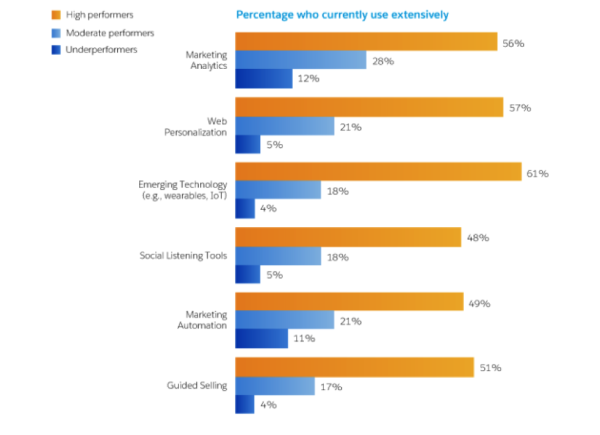
Simply having the right tools doesn’t necessarily mean that you know how to use them. But Salesforce’s 2016 State of B2B Marketing Report reveals that there’s an undeniable tie between using sales and marketing technology and B2B marketing performance:

Excerpt from Pardot Infographic
High performers, Salesforce found, use an average of 13 tools and technologies.
Underperformers? Only 5. While emerging technologies are playing a role for successful teams, 2016 isn’t shaping up to be all about tech—as we predicted, this year, it’s all about the customer experience.
A few years ago, most buyers faced a pretty disjointed process throughout the sales cycle. This year, Salesforce found that high-performing marketers are 13.6 times more likely to collaborate with other departments, eliminating the potential disconnect between marketing and sales as a marketing channel. Even setting the sales and marketing disconnect aside, prospects could still be getting overly generic, or worse, inconsistent messages from marketers on social, websites, email campaigns, etc.
It shouldn’t be a shock then that B2B marketers who rate themselves as “Excellent” for not only unifying all of those channels, but personalizing messages across multiple channels more often fall into the high-performer camp—by a wide margin.
How then do we reconcile that these high-performers are both unifying the lifecycle while using more disparate tools to achieve that goal? According to Scott Brinker, B2B marketers are comfortable adopting more and more solutions for two reasons:
- Almost every vendor in the space has invested engineering resources in making it easy (or at least easier) to integrate with the rest of the marketing technology ecosystem. Most marketing tech products now come with plug-and-play support for the major CRM and marketing automation platforms.
- The category of products known as iPaaS (integration-platforms-as-a-service) — along with new generations of tag management and other “marketing middleware” solutions — has grown significantly, making it easier to connect most or all of an organization’s marketing technology to a common data exchange backbone.
With B2B marketing solutions, the whole truly is greater than the sum of its parts. Scroll down to see more results from Salesforce’s findings on how B2B marketers view the customer lifecycle and use technology throughout.
Interested in how sales technology builds on and supports marketing technology? Download our free eBook, The Myth of Sales Enablement below.

